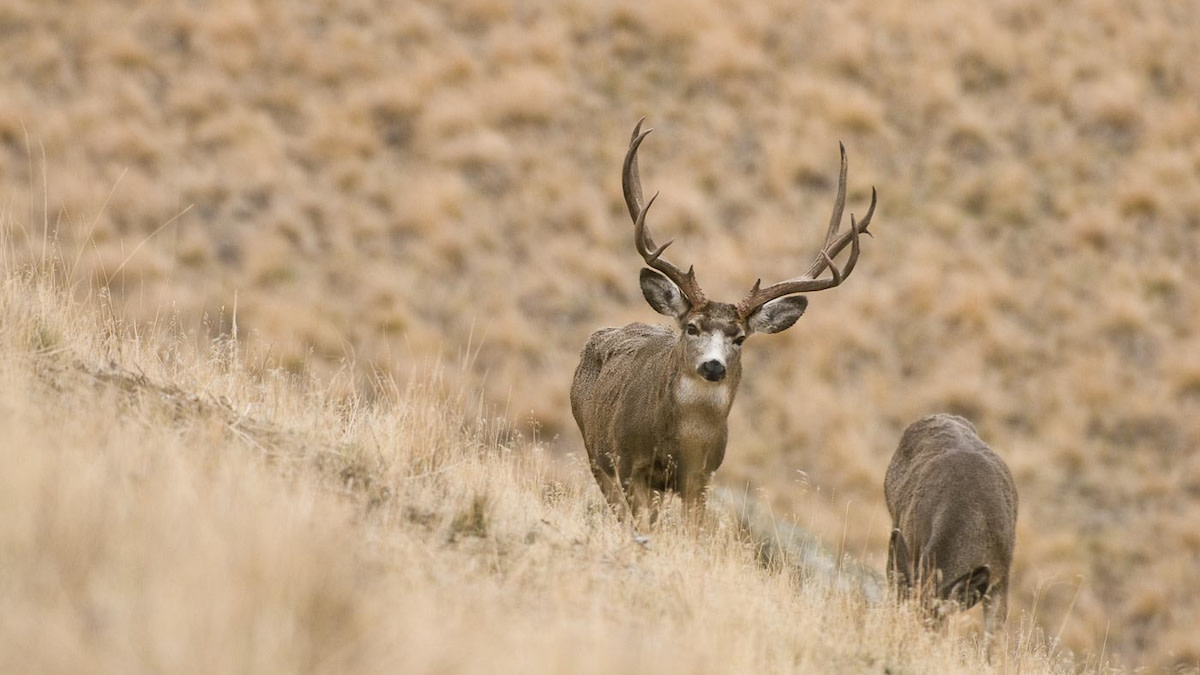
There’s nothing mule deer hunters love better than a rut hunt, and for good reason. That’s the season of the year when bucks are most visible and vulnerable. But not every hunting season coincides with the breeding season. Nor does every hunter have the chance to tread the deer trails in mid to late November when the rut ramps up over most mule deer habitat in the United States.
However, it’s possible to down a broad-eared buck earlier in autumn. Rather than seeking out a doe, he’s looking for a big meal, something to drink, and a place to sleep. Focus on those aspects of biology, and you'll find your buck.
What Pre-Rut Mule Deer Eat Mule deer are somewhat unique among hoofed animals. They’re a species known to mammal physiologists for having a relatively small gut and short intestinal tract. These features force them to ingest less forage than many of their ruminant kin and focus on easily-digested staples with high nutritional content. Thus, mule deer are quite selective in their use of habitat, seeking niches with the best forage within the broader boundaries that constitutes a herd’s year-round range.
Where do they find the best feed in the early hunting seasons? To solve that riddle, and hence discover the haunts of early or mid-season bucks, it’s helpful to understand the nutritional transition that occurs from late summer to autumn from a general standpoint and then focus on more specific habitats.
Mule deer are lovers of forbs, leafy green plants (non-grasses) that are highly nutritious. Researchers have found that forbs may make up nearly half of a mule deer’s nutritional intake in the summer. Although these browsers still consume lots of leaves, twigs, and buds from trees and shrubs, their penchant for forbs usually takes them to areas where these plants are most abundant during the summer.
Sam Stephens, a wildlife biologist with the Wyoming Game and Fish Department has observed deer in mountain habitats over his considerable career. Mule deer, like other animals, are actively trying to pack on fat reserves against winter starvation during September and October. “The forb base has to be there,” the veteran biologist emphasized. “Deer are selecting for nutrient-rich plants, those leafy, flowering plants.” Hanging basins at or just above timberline are veritable nurseries for forbs, many of which mature in late summer or early fall.
A couple of weeks into October, mountain mule deer may be drifting down to mid-elevation habitat where they sometimes hang out for a few weeks before moving onto lowland winter range. At this time, their diet will transition to mostly browse. “Earlier precipitation directly influences production of the tender new growth deer love to eat,” said Katie Cheesbrough, a WGFD biologist in southern Wyoming. Abundant rain in the summer produces more growth on shrubs, so deer tend to hang at mid-elevation longer than during dry years.
“Mule deer are now eating primarily shrubs, not grass and forbs,” Cheesbrough said. “Serviceberry, mountain mahogany, and bitterbrush are the primary species in our region. Previously burned areas are always a good place to look for early successional deciduous shrubs that mule deer like. Focus on the edges of the burns.”
How Mule Deer Drink The whereabouts of mountain mule deer aren’t usually influenced by water because there’s typically plenty of it in the high country. But elsewhere, access to surface water is highly determinant of mule deer distribution in early to mid autumn.
Mule deer need around half a gallon of water each day per 100 pounds of body weight. Thus, a 250-pound buck needs 1.25 gallons of water on a daily basis. Some of it may come from vegetation, but mule deer ingest most of their liquid from surface water: creeks, seeps, reservoirs, or stock tanks.
How far will mule deer venture from water? Not as far as a hunter might think. Research studies from Texas to New Mexico to Montana have shown that mule deer densities increase in relation to a reliable water source. Deer are rarely found more than 1.5 miles from water, even where habitat would otherwise seem ideal.
“Mule deer can have trouble finding surface water,” said Heather O’Brien, a state biologist in central Wyoming. “Look for seeps. You can spot them when you’re glassing the foothills by looking for aspens or willows. We consistently find deer in those pockets. It’s where we often look during our helicopter surveys.”
Where Mule Deer Bed As Sam Stephens noted earlier, forage is key to a mule deer buck’s backyard. But it needs to be located near bedding cover. “Look for forb communities adjacent to good cover, primarily timber patches and cliff breaks,” Stephens said.
Aspen groves also factor heavily into mountain mule deer hangouts. “Mule deer like those aspen pockets,” Stephens said. “The forbs will grow in the understory of aspens, so deer don’t have to go into the open to feed. It’s easier to locate deer in the aspens after the leaves have fallen. Beforehand, hunters may have to penetrate such cover to see deer.”
Out on the prairie, bedding cover is equally important. The tallest sagebrush is often located in draws and ravines that hold moisture, which nurtures the best forage as well. “During warmer-than-average hunting seasons, thermal cover in the form of shade can be super-attractive to deer,” O’Brien said.
Eighty-degree days aren’t unheard of during pre-rut hunting seasons at lower elevations. When that happens, mule deer curtail their activity shortly after daybreak and look for dense shade to escape the heat.
Killing a pre-rut mule deer buck is as simple as locating the habitat niches that provide for his biological needs. As an added bonus, your hunting partner may stop a stag as well. Prior to the rut, mature bucks are frequently found in bachelor bands sometimes numbering as many as a dozen animals. Locate buck and the odds are high that there’s another nearby.
Feature image via Tony Bynum





